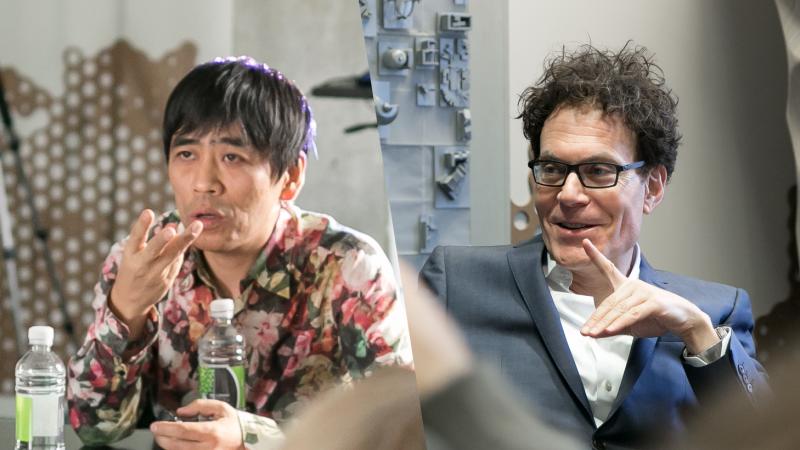Practice + Theory: 2016-17 Baumer Professors Ryue Nishizawa and Sanford Kwinter
The Fall 2016 semester Baumer Professor Ryue Nishizawa is an internationally recognized architect, while Spring 2017 semester Baumer Professor Sanford Kwinter is a distinguished architectural theorist. Nishizawa and Kwinter join a long list of prominent practitioners and scholars as Baumer Professors since the program’s inception in 1996, including Stan Allen, Zaha Hadid, Steven Holl, Eric Owen Moss, Greg Lynn, Sylvia Lavin, and last year’s Baumer Professors Neil Denari and Robert Somol. During the course of their time at Knowlton, Baumer Professors lead a graduate design seminar and present a public lecture as part of the School’s Baumer Lecture Series.

Ryue Nishizawa
The Baumer Seminar for the fall semester began at Grace Farms in New Canaan, Connecticut. Ryue Nishizawa met with third-year graduate architecture students to tour the grounds of Grace Farms, a non-profit community center located on an 80-acre site. The River Building, the site's primary building, and adjacent structures were designed by SANAA, the architectural firm co-founded by Nishizawa and Kazuyo Sejima in Tokyo, Japan.
The tour of the River Building allowed Knowlton School students to experience the site through the eyes of the architects. Kaley Overstreet, a graduate architecture student, commented: "The newness of the site to us seemed to be shared by Nishizawa and Sejima, who were seeing for the first time their building being used. They were very interested in how the various spaces were occupied by visitors to the center."
During the walk through the River Building, Nishizawa and Sejima answered questions and discussed topics related to the building's structural qualities, such as the intersection of the roof and glass walls, and the way in which the River Building integrates with the natural setting at Grace Farms. The long roof, which appears to float above the ground, follows the topography in a sinuous manner, forming courtyards and covered spaces as it winds and crosses the site. The glass-wrapped volumes create views and atmospheres that coalesce interior and exterior space, creating environments that allow engagement with nature from within the building.
These design characteristics were furthered discussed during the Baumer Seminar at the Knowlton School the following week. In addition to discussing the structure of his firm and the dynamics of its design process, Nishizawa addressed his inspirations from traditional Japanese traditions, specifically in blending architecture and landscape and in the use of large open spaces. He spoke, as well, how his designs have been informed by the work of modern masters, such as Le Corbusier's use of white, Philip Johnson's ideas of transparency, and Mies van der Rohe's minimalist approach. Nishizawa expounded on these influences and design techniques through a selection of his work, namely the Rolex Center, Teshima Art Museum, 21st Century Museum, S House and Grace Farms.
SANAA's Grace Farms was the winner of the 2014/2015 Mies Crown Hall Americas Prize, recognizing the most distinguished architectural works built on the North and South American continents. In 2010, Nishizawa and Sejima were the third pair to win the Pritzker Architecture Prize, whose jury commented: "they explore like few others the phenomenal properties of space, lightness, transparency and materiality to create a subtle synthesis."

Sanford Kwinter
Sanford Kwinter, a New York-based writer and theorist, currently is a professor of architecture at the European Graduate School, at The School of Architecture at the Pratt Institute and at the University of Applied Arts in Vienna, where he heads the Institute for Theory and History of Architecture. He also taught briefly at the Knowlton School in 1992.
Now spanning almost four decades, Kwinter's publishing career has covered the fields of architecture, science, design, technology and the humanities. He has contributed numerous essays and articles to a vast number of periodicals including: Art in America, L'autre Journal, Harvard Design Magazine, Yale Journal of Architecture and PRAXIS. Among the numerous fellowships Sanford Kwinter has received are those from the Canada Arts Council and the Getty Center for the History of Art and the Humanities. He was also the recipient of the 2013 Architecture Award from the American Academy of Arts and Letters.
Kwinter's Baumer Lecture Series presentation, which covered wide-ranging topics such as music, sound, psychotropy, brain functions and discontinuous space and time, was anticipated by Andrew Cruse, associate professor of architecture at the Knowlton School, who commented in his lecture introduction: "The topics that he writes about are infinitely big and impossibly complex. Yet around them he weaves very specific, sometimes personal, narratives which, although they must be read slowly, leave you intellectually breathless. These are written in a clear voice that is both imperious and doubt ridden; authoritative and hedging."
In addition to presenting in the Baumer Lecture Series, Kwinter conducted two, two-day Baumer Seminars with students in the third-year graduate architecture design studio. In preparation for the seminars, students analyzed a selection of his publications, such as Notes of the Third Ecology, De L'audace, Notes on Abominable Things and Urbanism: An Archivist's Art, to understand his approach to architecture and his method of forming a critical argument.
Referencing his education in comparative literature, Kwinter's seminar discussions evolved according to the same transdisciplinary approach of his lecture, illuminating connections and causalities among a number of topics. In his discussion of music, history and psychology, he gestured toward the connective tissue that both joins these disciplines, and shapes new paradigmatic frameworks of cognition, while referencing theorist such as Gilles Deleuze and Felix Guattari. He spoke lucidly concerning the power of language, and how those who know best to deploy it will have an advantage in the world to effect change. In reference to his early experiences as an editor and writer, Kwinter discussed his involvement in co-founding the independent publishing company Zone Books, with editors Michel Feher and Jonathan Crary, offering insights into the relationship between book design and content.


